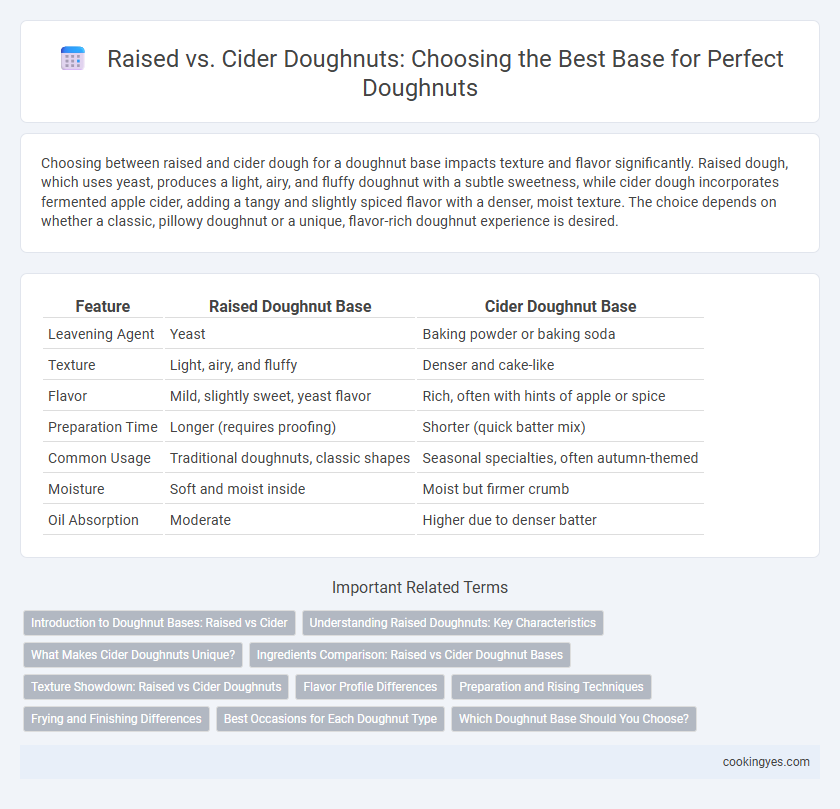Choosing between raised and cider dough for a doughnut base impacts texture and flavor significantly. Raised dough, which uses yeast, produces a light, airy, and fluffy doughnut with a subtle sweetness, while cider dough incorporates fermented apple cider, adding a tangy and slightly spiced flavor with a denser, moist texture. The choice depends on whether a classic, pillowy doughnut or a unique, flavor-rich doughnut experience is desired.
Table of Comparison
| Feature | Raised Doughnut Base | Cider Doughnut Base |
|---|---|---|
| Leavening Agent | Yeast | Baking powder or baking soda |
| Texture | Light, airy, and fluffy | Denser and cake-like |
| Flavor | Mild, slightly sweet, yeast flavor | Rich, often with hints of apple or spice |
| Preparation Time | Longer (requires proofing) | Shorter (quick batter mix) |
| Common Usage | Traditional doughnuts, classic shapes | Seasonal specialties, often autumn-themed |
| Moisture | Soft and moist inside | Moist but firmer crumb |
| Oil Absorption | Moderate | Higher due to denser batter |
Introduction to Doughnut Bases: Raised vs Cider
Raised doughnuts rely on yeast fermentation, creating a light, airy texture with a slightly tangy flavor that results from the natural leavening process. Cider doughnut bases incorporate apple cider or cider flavoring, adding a subtle fruity sweetness and moist crumb that pairs well with autumn spices. Both bases influence the doughnut's density, taste, and mouthfeel, with raised doughnuts offering a classic fluffiness, while cider doughnuts provide a seasonal twist and deeper flavor profile.
Understanding Raised Doughnuts: Key Characteristics
Raised doughnuts are made using yeast, resulting in a light and airy texture characterized by a soft, pillowy crumb and distinct rise during frying. The yeast fermentation process creates tiny air bubbles, giving raised doughnuts their signature fluffiness and subtle chewiness. Unlike cake doughnuts, raised doughnuts have a more delicate crumb structure and a slightly crisp outer crust due to the frying method and dough composition.
What Makes Cider Doughnuts Unique?
Cider doughnuts feature a distinct apple cider base that infuses the batter with natural fruity sweetness and subtle spice notes, differentiating them from traditional raised doughnuts. The cider's acidity reacts with leavening agents, creating a tender crumb and moist texture while delivering a warm, aromatic flavor profile. This combination of apple-rich ingredients and spice blends like cinnamon and nutmeg makes cider doughnuts uniquely seasonal and flavorful.
Ingredients Comparison: Raised vs Cider Doughnut Bases
Raised doughnut bases primarily use yeast, flour, sugar, milk, and eggs, producing a light, airy texture with subtle sweetness. Cider doughnut bases incorporate apple cider and spices like cinnamon and nutmeg, adding natural fruity flavor and a denser crumb. The choice of base affects the doughnut's rise, moisture, and overall flavor profile, with raised doughnuts being fluffier and cider doughnuts offering a spiced, moist bite.
Texture Showdown: Raised vs Cider Doughnuts
Raised doughnuts feature a light, airy texture achieved through yeast fermentation, resulting in a soft, fluffy bite that absorbs glazes and fillings well. Cider doughnuts use spiced apple cider in the batter, producing a denser, moist crumb with a tender, cake-like consistency enriched by warm cinnamon and nutmeg notes. The texture showdown highlights raised doughnuts' springy chewiness versus cider doughnuts' rich, tender density, each offering unique sensory appeal.
Flavor Profile Differences
Raised doughnuts offer a light, airy texture with a mild sweetness and subtle yeast aroma, enhancing the classic doughnut flavor. Cider doughnut bases incorporate apple cider, imparting a warm, spiced profile with notes of cinnamon and nutmeg, creating a richer and more complex taste. The choice between raised and cider doughnut bases influences both the texture and the aromatic depth, appealing to different flavor preferences.
Preparation and Rising Techniques
Raised doughnuts require yeast fermentation, involving a longer proofing period to allow the dough to rise and develop a light, airy texture; the dough is kneaded and then left to rise until doubled in size before shaping and frying. Cider doughnut batter, often using baking powder or baking soda as leavening agents, relies on chemical rising, which creates a quicker preparation time and results in a denser, cake-like texture. The choice between raised and cider doughnuts impacts the preparation method significantly, with raised doughnuts demanding more time and careful temperature control during proofing, while cider doughnuts prioritize immediate mixing and frying after batter preparation.
Frying and Finishing Differences
Raised doughnuts use yeast as a leavening agent, resulting in a light, airy texture that requires frying at a consistent temperature between 350degF and 375degF to achieve a golden-brown exterior without absorbing excess oil. Cider doughnuts incorporate cider for added flavor and a denser crumb, often benefiting from a slightly lower frying temperature and shorter cooking time to prevent over-browning and preserve the characteristic apple notes in the finish. Both varieties require careful temperature control during frying to optimize texture and flavor but differ in their finishing touches, with raised doughnuts often glazed or sugared while cider doughnuts are typically dusted with cinnamon sugar to complement their spiced undertones.
Best Occasions for Each Doughnut Type
Raised doughnuts, with their light and airy texture, are ideal for casual gatherings and breakfast events due to their fluffy consistency and ease of eating. Cider doughnuts, infused with warm spices and a denser crumb, perfectly suit autumn celebrations and festive occasions like Halloween or Thanksgiving, enhancing seasonal flavors. Each doughnut type complements specific settings by matching the event's mood and culinary theme.
Which Doughnut Base Should You Choose?
Raised doughnuts, made with yeast, offer a light, airy texture that absorbs glazes and fillings well, making them ideal for classic and filled varieties. Cake doughnuts, such as cider-based ones, provide a denser, crumbly bite with a slight tang from the cider, enhancing flavor complexity for those preferring a rich taste. Choose raised doughnuts for softness and versatility, or cider cake doughnuts for a robust, flavorful base that holds up to hearty toppings.
Raised vs Cider for Doughnut Base Infographic

 cookingyes.com
cookingyes.com